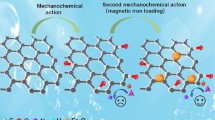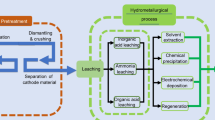Abstract
In this study, in situ electrochemical synthesis of Ni–Mg–Al–LDHs for the treatment of simulated strontium-containing liquid radioactive waste (LRW) from nuclear power plants. The optimal reaction conditions were obtained by single-factor experiments: initial pH of 12, Mg electrode current density (JMg) of 12.5 mA/cm2, Ni–Mg–Al metal molar ratio (RNi_Mg–Al) of 3:1:1 and reaction temperature (T) of 30 °C. The removal rate of Sr2+ can reach up to 99.65%. The synthetic precipitate was characterized by XRD, FESEM-EDS and FT-IR under optimal reaction conditions. The XRD pattern showed that the main component of the precipitate is Ni–Mg–Al–LDHs. The precipitate was characterized by FESEM to have distinct layered double hydroxides (LDHs) structure. The absorption peaks of O–H bonds, C–O bonds, and M–O–M (M is Ni, Mg and Al) bonds appeared in IR spectrum. The method of in situ electrochemical synthesis of Ni–Mg–Al–LDHs has promising applications in the treatment of LRW.













Similar content being viewed by others
References
Alby D, Charnay C, Heran M, Prelot B, Zajac J (2018) Recent developments in nanostructured inorganic materials for sorption of cesium and strontium: synthesis and shaping, sorption capacity, mechanisms, and selectivity—A review. J Hazard Mater 344:511–530. https://doi.org/10.1016/j.jhazmat.2017.10.047
Cohen-Solal M (2002) Strontium overload and toxicity: impact on renal osteodystrophy. Nephrol Dial Transpl 17:30–34. https://doi.org/10.1093/ndt/17.suppl_2.30
Szabo J, Minamyer S (2014) Decontamination of radiological agents from drinking water infrastructure: a literature review and summary. Environ Int 72:129–132. https://doi.org/10.1016/j.envint.2014.01.020
Kusumkar VV, Galambos M, Viglasova E, Dano M, Smelkova J (2021) Ion-imprinted polymers: synthesis, characterization, and adsorption of radionuclides. Materials 14:1083–1112. https://doi.org/10.3390/ma14051083
Ngwenya N, Chirwa EMN (2011) Biological removal of cationic fission products from nuclear wastewater. Water Sci Technol 63:124–128. https://doi.org/10.2166/wst.2011.021
Hodkin DJ, Stewart DI, Graham JT, Burke IT (2016) Coprecipitation of (14)C and Sr with carbonate precipitates: the importance of reaction kinetics and recrystallization pathways. Sci Total Environ 562:335–343. https://doi.org/10.1016/j.scitotenv.2016.03.192
Ivanets A, Milyutin V, Shashkova I, Kitikova N, Nekrasova N, Radkevich A (2020) Sorption of stable and radioactive Cs (I), Sr (II), Co (II) ions on Ti–Ca–Mg phosphates. J Radioanal Nucl Chem 324:1115–1123. https://doi.org/10.1007/s10967-020-07140-6
Yuan H, Shao L, Huang L, Huang G (2019) Treatment of simulated radioactive Sr2+-containing wastewater by electrolysis of in-situ synthesis of manganese oxide. Ind Water Treat 1:82–86 (in Chinese)
Gürboğa G, Tel H (2005) Preparation of TiO2–SiO2 mixed gel spheres for strontium adsorption. J Hazard Mater 120(1–3):135–142. https://doi.org/10.1016/j.jhazmat.2004.12.037
Oh JM, Hwang SH, Choy JH (2002) The effect of synthetic conditions on tailoring the size of hydrotalcite particles. Solid State Ionics 151(1–4):285–291. https://doi.org/10.1016/j.jhazmat.2010.06.067
Kannan S, Narayanan A, Swamy CS (1996) Effect of composition on the physicochemical properties of nickel aluminium hydrotalcites. J Mater Sci (UK) 31:2353–2360. https://doi.org/10.1007/bf01152946
Pigna M, Dynes JJ, Violante A, Sommella A, Caporale AG (2016) Sorption of arsenite on Cu-Al, Mg-Al, Mg-Fe, and Zn-Al layered double hydroxides in the presence of inorganic anions commonly found in aquatic environments. Environ Eng Sci 33:98–104. https://doi.org/10.1089/ees.2015.0131
Guo YW, Zhu ZL, Qiu YL, Zhao JF (2013) Enhanced adsorption of acid brown 14 dye on calcined Mg/Fe layered double hydroxide with memory effect. Chem Eng J 219:69–77. https://doi.org/10.1016/j.cej.2012.12.084
Kovanda F, Kolousek D, Kalouskova R, Vymazal Z (2001) Starting production of synthetic hydrotalcite in the Czech Republic. Chem Listy 95:493–497
Shimamura A, Kanezaki E, Jones MI, Metson JB (2012) Direct observation of grafting interlayer phosphate in Mg/Al layered double hydroxides. J Solid State Chem 186:116–123. https://doi.org/10.1016/j.jssc.2011.11.034
Zhang H, Li K, Liang Z, Wan Y, Feng Z, Liu J, Wang M (2022) Replacement of interlayer anion via memory effect of layered double hydroxide: a promising strategy for fabricating nanostructures with better flame-retardant performance. J Phys Chem Solids 170:110932
Iyi N, Ebina Y, Sasaki T (2011) Synthesis and characterization of water-swellable LDH (layered double hydroxide) hybrids containing sulfonate-type intercalant. J Mater Chem 21:8085–8095. https://doi.org/10.1039/c1jm10733j
Barabi A, Seidi S, Rouhollahi A, Manouchehri M, Shanehsaz M, Rasouli F (2020) Electrochemically synthesized NiFe layered double hydroxide modified Cu(OH)2 needle-shaped nanoarrays: a novel sorbent for thin-film solid phase microextraction of antifungal drugs. Anal Chim Acta 1131:90–101. https://doi.org/10.1016/j.aca.2020.07.053
Huang X, Sun R, Li YL, Jiang JB, Li MJ, Xu WX, Wang YY, Cong HS, Tang JB, Han S (2022) Two-step electrodeposition synthesis of heterogeneous NiCo-layered double hydroxides@MoO3 nanocomposites on nickel foam with high performance for hybrid supercapacitors. Electrochim Acta 403:139680–139692. https://doi.org/10.1016/j.electacta.2021.139680
Huang G, Jiang L, Shao L, Yang X, Huang J (2020) In situ electrochemical synthesis of Zn-Al layered double hydroxides for removal of strontium. Colloids Surf Physicochem Eng Asp 597:124785–124793. https://doi.org/10.1016/j.colsurfa.2020.124785
Jiang L, Huang G, Shao L, Huang J, Peng S, Yang X (2021) In situ electrochemical synthesis of Zn-Al layered double hydroxides for removal of strontium: optimization and kinetics study. Colloids Surf Physicochem Eng Asp 608:125589–125596. https://doi.org/10.1016/j.colsurfa.2020.125589
Peng SM, Jiang L, Yu X, Yang X, Huang GT (2021) Removal of strontium by in situ electrochemical synthesis of Zn-Al LDHs using a bidirectional pulse method. New J Chem 45:20915–20927. https://doi.org/10.1039/d1nj03502a
Yang FC, Sun SQ, Chen XQ, Chang Y, Zha F, Lei ZG (2016) Mg-Al layered double hydroxides modified clay adsorbents for efficient removal of Pb2+, Cu2+ and Ni2+ from water. Appl Clay Sci 123:134–140. https://doi.org/10.1016/j.clay.2016.01.026
Gao L, Deng S (2005) Study on spectrophotometric determination of strontium with dibromo-p-methylsulfonazo and its application. Metall Anal 25:65–66. https://doi.org/10.13228/j.issn.1000-7571.2005.06018
Yin L, Hu Y, Ma R, Wen T, Wang X, Hu B, Wang X (2019) Smart construction of mesoporous carbon templated hierarchical Mg-Al and Ni-Al layered double hydroxides for remarkably enhanced U (VI) management. Chem Eng J 359:1550–1562. https://doi.org/10.1016/j.cej.2018.11.017
Zha CC, Sun XL, Li N, Yu SM (2014) In-situ synthesis of hydrotalcite and its application in separation of simulated radionuclide Eu (III). Korean J Chem Eng 31:1859–1864. https://doi.org/10.1007/s11814-014-0132-1
Tran HN, Nguyen DT, Le GT, Tomul F, Lima EC, Woo SH, Sarmah AK, Nguyen HQ, Nguyen PT, Nguyen DD, Nguyen TV, Vigneswaran S, Vo DVN, Chao HP (2019) Adsorption mechanism of hexavalent chromium onto layered double hydroxides-based adsorbents: a systematic in-depth review. J Hazard Mater 373:258–270. https://doi.org/10.1016/j.jhazmat.2019.03.018
Cruz IO, Ribeiro NFP, Aranda DAG, Souza M (2008) Hydrogen production by aqueous-phase reforming of ethanol over nickel catalysts prepared from hydrotalcite precursors. Catal Commun 9:2606–2611. https://doi.org/10.1016/j.catcom.2008.07.031
Yu X, Peng SM, Cao W, Huang GT (2022) Efficient adsorption of strontium by in situ electrochemical synthesis of monohydric phosphate intercalated layered double hydroxides. New J Chem 46:18190–18198. https://doi.org/10.1039/d2nj03311a
Suvokhiaw S, Imyim A, Sukpirom N (2016) As(V) removal using a magnetic layered double hydroxide composite. Sep Sci Technol 51:2948–2957. https://doi.org/10.1080/01496395.2016.1231206
Ma SL, Chen QM, Li H, Wang PL, Islam SM, Gu QY, Yang XJ, Kanatzidis MG (2014) Highly selective and efficient heavy metal capture with polysulfide intercalated layered double hydroxides. J Mater Chem A 2:10280–10289. https://doi.org/10.1039/c4ta01203h
Saiah FBD, Su BL, Bettahar N (2009) Nickel-iron layered double hydroxide (LDH): Textural properties upon hydrothermal treatments and application on dye sorption. J Hazard Mater 165:206–217. https://doi.org/10.1016/j.jhazmat.2008.09.125
Wang X, Cai YW, Han TH, Fang M, Chen KC, Tan XL (2020) Phosphate functionalized layered double hydroxides (phos-LDH) for ultrafast and efficient U(VI) uptake from polluted solutions. J Hazard Mater 399:123081–123124. https://doi.org/10.1016/j.jhazmat.2020.123081
Tao Q, Reddy BJ, He HP, Frost RL, Yuan P, Zhu JX (2008) Synthesis and infrared spectroscopic characterization of selected layered double hydroxides containing divalent Ni and Co. Mater Chem Phys 112:869–875. https://doi.org/10.1016/j.matchemphys.2008.06.060
Zhang XL, Dou YK, Gao CG, He CY, Gao JT, Zhao SJ, Deng LC (2019) Removal of Cd(II) by modified maifanite coated with Mg-layered double hydroxides in constructed rapid infiltration systems. Sci Total Environ 685:951–962. https://doi.org/10.1016/j.scitotenv.2019.06.228
Guo YD, Gong ZH, Li CX, Gao B, Li P, Wang XG, Zhang BC, Li XM (2020) Efficient removal of uranium (VI) by 3D hierarchical Mg/Fe-LDH supported nanoscale hydroxyapatite: A synthetic experimental and mechanism studies. Chem Eng J 392:123682–123737. https://doi.org/10.1016/j.cej.2019.123682
Acknowledgements
The authors sincerely appreciate the help of the analysts from Center of Analysis and Test, Laboratory for Resource and Environmental Education in East China University of Science and Technology.
Author information
Authors and Affiliations
Contributions
XH: Investigation, Writing—original draft. XY: Investigation, Formal analysis. WC: Investigation. XW: Investigation. SW: Investigation. GH: Conceptualization, Methodology, Resources.
Corresponding author
Ethics declarations
Conflict of interest
There are no conflicts to declare.
Additional information
Publisher's Note
Springer Nature remains neutral with regard to jurisdictional claims in published maps and institutional affiliations.
Rights and permissions
Springer Nature or its licensor (e.g. a society or other partner) holds exclusive rights to this article under a publishing agreement with the author(s) or other rightsholder(s); author self-archiving of the accepted manuscript version of this article is solely governed by the terms of such publishing agreement and applicable law.
About this article
Cite this article
Huang, X., Yu, X., Cao, W. et al. In situ electrochemical synthesis of Ni–Mg–Al–LDHs for the treatment of simulated strontium-containing liquid radioactive waste from nuclear power plants. J Radioanal Nucl Chem 333, 411–420 (2024). https://doi.org/10.1007/s10967-023-09243-2
Received:
Accepted:
Published:
Issue Date:
DOI: https://doi.org/10.1007/s10967-023-09243-2




